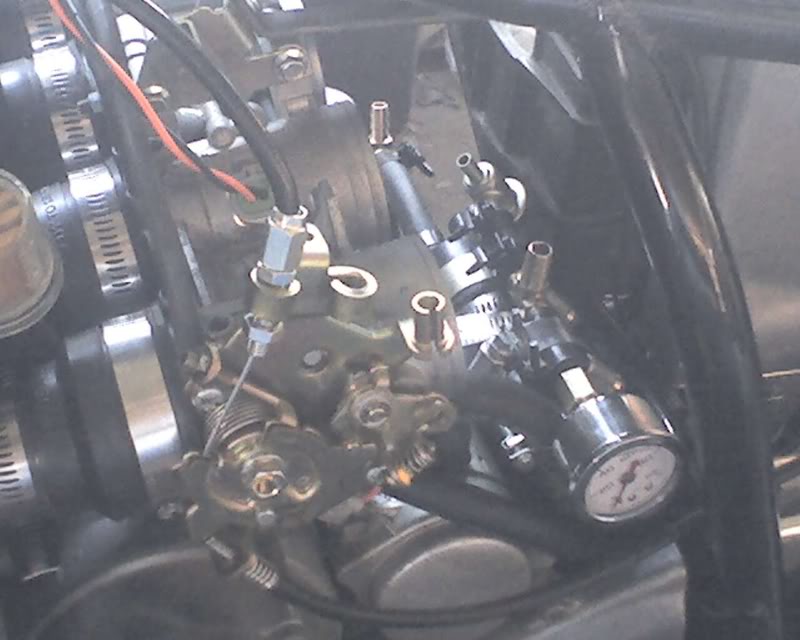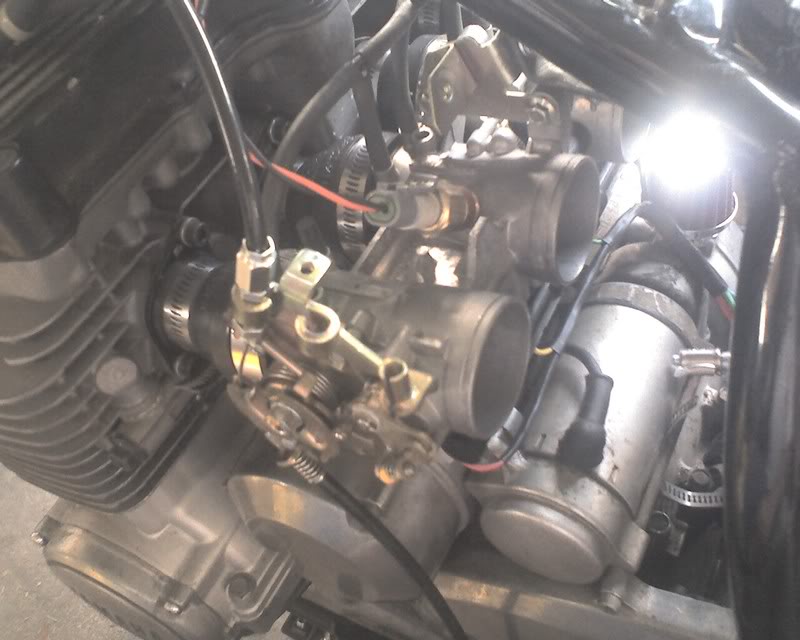Over the last couple of days, I’ve been thinking of points of summary that I want to share about the project. This post may therefore seem to have a rambling quality to it.
The CLT sensor mounted where it is, just inboard of the #2 spark plug, seems to work well. Once it indicates 140 degrees and I take it off fast idle, it’s pretty well warm. I may move that point up a few degrees this winter. I will have to see how he runs. I also need to find/build a proper cable so I can use the stock choke lever to operate fast idle. As it stands, I have to manually operate the cam and hold it during the warm up period.
The fuel tank return went well. I had to completely reroute the fuel lines to get flow from the tank. I had to use the old original vacuum line to operate the petcock, but the rubber has hardened and doesn’t seal very well at the tap (cylinders 2&3 teed’). I had to leave it in the PRI position to get fuel to the pump. At least there’s no float valve seat to worry about, not as such anyway. I’m pretty sure I have more vacuum line to replace it; I just couldn’t find it Saturday afternoon!

So, once the fuel tank and seat were on and the brakes refilled and bled (see brake detail below), I took Buzz for the first ride on MegaSquirt and in fact, the first ride at all since last January. Having ridden Ruby all this time, it took a bit to make my feet go the right places and directions. I had trouble finding the rear brake and in fact, had a millisecond of panic while rolling leisurely down the driveway.  But, everything came back pretty quick and as I rode off, everything seemed to be working well enough. I found pretty quickly, however, that I could ride very gently without issue, but beyond a certain (small) throttle opening, it just didn’t work right, bogging down. I could reach the 45 MPH speed limit at a socially responsible rate, but not in any kind of a hurry.
But, everything came back pretty quick and as I rode off, everything seemed to be working well enough. I found pretty quickly, however, that I could ride very gently without issue, but beyond a certain (small) throttle opening, it just didn’t work right, bogging down. I could reach the 45 MPH speed limit at a socially responsible rate, but not in any kind of a hurry.
By the time I was on my way back home (ran about 4 miles total), I could detect a faint smell of gasoline when stopped and was worried about a leak. Also by then, the intake reducers had softened somewhat from engine heat (see intake detail below) and I was somewhat concerned that they might fail.
Back in the driveway, I could find no evidence of a leak, but I could smell fumes from around the tank filler cap. I opened and reclosed it; maybe it wasn’t seated well. Even though the intakes had softened a lot, I think with the weight being carried by the mounting bracket, the intakes would probably not fail, at least not in the short term.
It was time to button up the garage, get myself cleaned up and go pick up my Lovely and her Mom at the airport; they’d been away on a trip all week, which is one reason I had so much time this week to dedicate to this project.
In the time since Satuday, I have figured out two things about the tach input. First, it’s reading half speed because I’m only connected to one of the two coils. I misunderstood what the tach input wants. I guess at some level, I was thinking about a timing light picking up a single pulse from cylinder 1. Connecting both coils to the tach input is pretty trivial, using diodes to isolate them from one another. This will get the tach reading up to reality and with a few minutes’ spare time, I hope to get that done this evening.
I also underestimated the value of a proper tachometer data. I figured it was a go/no-go thing at most. However, without a mass airflow sensor, MegaSquirt has to calculate the volume of air going through the engine to know the amount of fuel to provide. This calculation depends primarily on two things, the constant representing the displacement of the engine and (you’ll never guess) the RPM! The tach being at reality should mostly fix the worst problem I experienced in my 4 mile test ride Saturday afternoon. As you will recall, the bike seems to run pretty well at very modest throttle openings, but bogs tremendously at much over what I suspect is about 5% throttle. Upon reflection, I’m sure that MegaSquirt was only providing enough fuel for half the rpm that the engine was actually running. Makes perfect sense! I’m trying to run 5000 RPM and MegaSquirt thinks I’m only running 2500, and so only gives me half the fuel I need. At lunch today, I spent $1.07 for two diodes that, once applied, should fix this problem.
The throttle cable, while not exactly in the greatest location, is at least not as interfering as I may have expected. With the tank in place, the throttle cable just protrudes from under the tank. Under exactly the right conditions, I feel the throttle body vibrating against my knee. I still want to fit a plate over the assembly to ensure garments don’t get snagged on the throttle cam.
I have ordered air filters. I bit the bullet and got K&N’s, though I got about the cheapest K&N’s that fit. Other filters just don’t have the reputation that K&N has. In the same order, I also got air filter cleaning/oiling supplies, oil filters and a couple of decals. I may see if I can get decals for all my suppliers (you know, companies from who’s products I’ve robbed parts off of, Suzuki, Kawasaki, Ford, hehehe) and decorate only the side covers with them. The filters are a set, part number RU-1824. There are 4 tapered oval filters with 52mm offset flanges. I think that will be the most effective use of the available space.
The neoprene intake couplers got pretty soft during my short ride. By the time I got back home, rather than only the coupler pulsing like a panting lizard, the entire throttle body assembly thrusts in and out by a few millimeters. I have found reinforced silicone intakes that I will order once I have verified the dimensions. I thought I remember them as 1.5″ x 2.0″, but I didn’t want to place a $50 order and have it be the wrong thing. These are probably the same overall length, so I probably won’t need to redo the throttle body mounting braces. These should be quite a lot stiffer than the plumbing parts.
As for a few non-EFI issues, I got the brakes back in operation, but something is definitely amiss there. Actually, the front brake has been a little iffy on Buzz ever since I’ve had him. The brake’s never had the power it should. I’ve had an unintentional antilock brake because it simply won’t lock up. It stops, though, and that’s helpful.
The forks feel a bit soft, too. I need to verify that everything else is normal, but there is an oily dusty bathtub ring on the downtubes, so I think the fork seals need replacing. Consequently, chances are that it’s a few millimeters short on fork oil.
There is a rubber guard that ideally supports itself and keeps the chain from throwing oil up where it can be seen, directly above the shift lever. This rubber part doesn’t like to stay on and fell down into the drive sprocket. Judging by the sound and feel, I think it’s been summarily chewed up. By the time I was back from my ride, I’ll bet it’s been spat out, as well. This general vicinity probably needs some long term guard applied to ensure that MegaSquirt wiring never gets into the chain.




